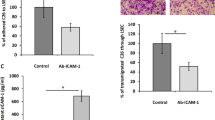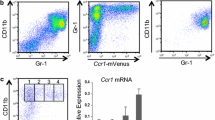Abstract
Carcinoembryonic antigen (CEA) injected intravenously into athymic nude mice increases the ability of weakly metastatic human colorectal carcinoma (CRC) cells to colonize liver in an experimental metastasis assay. Since CEA acts as an intercellular adhesion molecule in vitro, several investigators have postulated that this facilitation of experimental metastasis may be mediated through adhesion between CEA on CRC and CEA-binding proteins on Kupffer or other cells lining the hepatic sinusoid. The present work tested this postulate both by intravital fluorescence videomicroscopy in vivo and in adhesion assays in vitro to enriched populations of Kupffer cells and hepatic sinusoidal endothelial cells (SEC). The data indicate that CEA expression does not effect adhesion to enriched Kupffer cells or SEC in vitro. These data suggest that CEA enhances liver colonization through another mechanism, possibly one that involves modulation of the hepatic response to tumor cell implantation.
Similar content being viewed by others
References
Williams AF, Barclay AN. The immunoglobulin superfamily: Domains for cell surface recognition. Ann Rev Immunol 1988; 6:381.
Gold P, Freedman SO. Demonstration of tumor-specific antigens in human colonic carcinoma by immunological tolerance and absorption techniques. J Exp Med 1965; 121: 439–462.
Clinical practice guidelines for the use of tumor markers in breast and colorectal cancer. Adopted on May 17, 1996 by the American Society of Clinical Oncology. J Clin Oncol 1996; 14: 2843–77.
Fielding LP, Pettigrew N. College of American Pathologists Conference XXVI on clinical relevance of prognostic markers in solid tumors. Report of the Colorectal Cancer Working Group. Arch Pathol Lab Med 1995; 119: 1115–21.
Jessup JM, Giavazzi R, Campbell D, Cleary K, Morikawa K, Fidler IJ. Growth potential of human colorectal carcinoma in nude mice: Association with the preoperative serum concentration of carcinoembryonic antigen in patients. Cancer Res 1998; 48: 1689–92.
Tibbetts LM, Doremus CM, Tzanakakis GN, Vezeridis MP. Liver metastases with 10 human colon carcinoma cell lines in nude mice and association with carcinoembryonic antigen production. Cancer 1993; 71: 315–21.
Jessup JM, Petrick AT, Toth CA et al. Carcinoembryonic antigen: Enhancement of liver colonisation through retention of human colorectal carcinoma cells. Br J Cancer 1993; 67: 464–70.
Hostetter RB, Augustus LB, Mankarious R et al. Carcinoembryonic antigen as a selective enhancer of colorectal cancer metastasis. J Natl Cancer Inst 1990; 82: 380–85.
Benchimol S, Fuks A, Jothy S et al. Carcinoembryonic antigen, a human tumor marker, functions as an intercellular adhesion molecule. Cell 1989; 57: 327–34.
Oikawa S, Inezuka C, Kwoki M et al. Cell adhesion activity of nonspecificcross-reacting antigen (NCA) and carcinoembryonic antigen (CEA) expressed on CHO cell surface: Homophilic and heterophilic adhesion. Biochem Biophys Res Comm 1989; 164: 39–48.
Zhou H, Fuks A, Alcaraz G et al. Homophilic adhesion between Ig superfamily carcinoembryonic antigen molecules involves double reciprocol bonds. J Cell Biol 1993; 122: 951–60.
Jessup JM, Kim JC, Thomas P et al. Adhesion to carcinoembryonic antigen by human colorectal carcinoma cells involves at least two epitopes. Int J Cancer 1993; 55: 262–68.
Jessup JM, Thomas P. Carcinoembryonic antigen: Function in metastasis by human colorectal carcinoma. Cancer Metastasis Rev 1989; 8: 263–80.
Edmiston K, Gangopadhyay A, Shoji Y et al. In vivo induction of murine cytokine production by carcinoembryonic antigen. Cancer Res 1997; 57: 4432–36.
Ishii S, Mizoi T, Kawano K et al. Implantation of human colorectal carcinoma cells in the liver studied by in vivo fluorescence video microscopy. Clin Exp Met 1996; 14: 153–64.
Toth CA, Thomas P, Broitman SA, Zamcheck N. Receptor mediated endocytosis of carcinoembryonic antigen by rat liver Kupffer cells. Cancer Res 1985; 45: 392–97.
Thomas P, Petrick AT, Toth CA et al. A peptide sequence on carcinoembryonic antigen binds to a 80kD protein on Kupffer cells. Biochem Biophys Res Commun 1992; 188: 671–77.
Ohannesian DW, Dafna L, Thomas P et al. Carcinoembryonic antigen and other glycoconjugates act as ligands for galectin-3 in human colon carcinoma cells. Cancer Res 1995; 55: 2191–99.
Ohannesian DW, Lotan D, Lotan R. Concomitant increases in galectin-1 and its glycoconjugate ligands (carcinoembryonic antigen, lamp-1, and lamp-2) in cultured human colon carcinoma cells by sodium butyrate. Cancer Res 1994; 54: 5992–6000.
Lotan R, Belloni PN, Tressler RJ et al. Expression of galectins on microvessel endothelial cells and their involvement in tumour cell adhesion. Glycoconj J 1994; 11: 462–8.
Meterissian SH, Toth CA, Steele G Jr, Thomas P. Kupffer cell/tumor cell interactions and hepatic metastasis in colorectal cancer. Cancer Lett 1994; 81: 5–12.
Edmiston KH, Shoji Y, Mizoi T et al. Role of nitric oxide and superoxide anion in elimination of low metastatic human colorectal carcinomas by unstimulated hepatic sinusoidal endothelial cells. Cancer Res 1998; 58: 1524–31.
Mørland B, Kaplan G.Macrophage activation in vivo and in vitro. Exp Cell Res 1977; 108: 279–88.
Irving MG, Roll FJ, Huang S, Bissell DM. Characterization and culture of sinusoidal endothelium from normal rat liver: Lipoprotein uptake and collagen phenotype. Gastroenterology 1984; 87: 1233–47.
Phillips NC, Rioux J, Tsao MS. Activation of murine Kupffer cell tumoricidal activity by liposomes containing lipophilic muramyl dipeptide. Hepatology 1988; 8: 1046–50.
Sack T, Gum J, Low M, Kim Y. Release of carcinoembryonic antigen from human colon cancer cells by phosphoinositol-specific phospholipase C. J Clin Invest 1988; 82: 586–93.
Hefta S, Hefta L, Lee T, Paxton R, Shively J. Carcinoembryonic antigen is anchored to membranes by covalent attachement to a glycosylphosphatidylinosito lmoiety: Identification of the ethanolamine linkage site. Proc Natl Acad Sci USA 1988; 85: 4648–52.
Ishii S, Ford R, Nachman A et al. Normal colonic epithelium adheres to carcinoembryonic antigen and type IV collagen. Gastroenterology 1994; 106: 1242–50.
Thomas P, Gangopadhyay A, Steele G Jr et al. The effect of transfection of the CEA gene on the metastatic behavior of the human colorectal cancer cell line MIP-101. Cancer Letters 1995; 92: 59–66.
Kim JC, Roh SA, Park KC. Adhesive function of carcinoembryonic antigen in the liver metastasis of km-12c colon carcinoma cell line. Dis Colon Rectum 1997; 40: 946–53.
Yoshioka T, Masuko T, Kotanagi H et al. Homotypic adhesion through carcinoembryonic antigen plays a role in hepatic metastasis development. Jpn J Cancer Res 1988; 89: 177–85.
Hashino J, Fukuda Y, Oikawa S et al. Metastatic potential of human colorectal carcinoma SW1222 cells transfected with cDNA encoding carcinoembryonic antigen. Clin Exp Metastasis 1994; 12: 324–8.
Hashino J, Fukuda Y, Oikawa S et al. Metastatic potential in nude mice of Chinese hamster ovary cells expressing human carcinoembryonic antigen. Biochem Biophys Res Commun 19974; 200: 1748–53.
Majuri ML, Hakkarainen M, Paavonen T, Renkonen R. Carcinoembryonicantigen is expressed on endothelial cells. A putative mediator of tumor cell extravasation and metastasis. APMIS 1994; 102: 432–38.
Stocks SC, Kerr MA, Haslett C, Dransfield I. CD66–dependent neutrophil activation: A possible mechanism for vascular selectinmediated regulation of neutrophil adhesion. J Leukoc Biol 1995; 58: 40–48.
Skubitz KM, Campbell KD, Skubitz AP. CD66a, CD66b, CD66c, and CD66d each independently stimulate neutrophils. J Leukoc Biol 1996;60: 106–17.
Jessup JM, Thomas P, CEA and Metastasis: A facilitator of sitespecific metastasis. In Stammers L (ed): Cell Adhesion and Communication Mediated by the CEA Family: Basic and Clinical Perspectives. Amsterdam: Harwood Academic Publishers 1998; 195–222.
Prado IB, Laudanna AA, Carneiro CR. Susceptibility of colorectalcarcinoma cells to natural-killer-mediated lysis: Relationship to CEA expression and degree of differentiation. Int J Cancer 1995; 61: 854–60.
Kammerer R, von Kleist S. CEA expression of colorectal adenocarcinomas is correlated with their resistance against LAK-cell lysis. Int J Cancer 1994; 57: 341–7.
Rivoltini L, Cattoretti G, Arienti F et al. CEA and NCA expressed by colon carcinoma cells affect their interaction with and lysability by activated lymphocytes. Int J Biol Markers 1992; 7: 143–7.
Clark DA, McCulloch PB, Liao SK et al. Sensitivity of human carcinoma cell lines to lysis by blood natural killer cells correlating with surface expression of carcinoembryonic antigen. J Natl Cancer Inst 1984; 72: 505–12.
Jessup JM, Battle P, Waller H et al. Reactive nitrogen and oxygen radicals formed during hepatic ischemia-reperfusion kill weakly metastatic colorectal cancer cells. Cancer Res 1999; 59: 1825–9.
Author information
Authors and Affiliations
Rights and permissions
About this article
Cite this article
Jessup, J., Ishii, S., Mitzoi, T. et al. Carcinoembryonic antigen facilitates experimental metastasis through a mechanism that does not involve adhesion to liver cells. Clin Exp Metastasis 17, 481–488 (1999). https://doi.org/10.1023/A:1006685817395
Issue Date:
DOI: https://doi.org/10.1023/A:1006685817395




